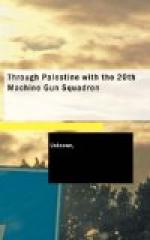Having arrived at Amr, further progress was made in the training of the unit. Each day one man was “told off” to three animals, the remainder thus being free for work on the gun. The “horse-men” did one hour on the gun, remainder of day on animals. “Gun-numbers” worked one hour at stables and the remainder of the day on the gun. The daily routine was as follows:—Reveille 04.30; Parades, 06.30 to 10.00 and 15.00 to 17.30. Horses were watered twice (from troughs at the railway), and fed four times a day.
As early as September 8th, there was a test “turn-out” of the Squadron in full marching order, with guns on packs. The new regulations regarding rations and forage included “Iron” and two days’ emergency-rations (in wallets) for the man, and one day’s emergency-forage (9 lbs. of grain), in a “sandbag” rolled in a ground-sheet and carried on the front arch of the saddle, for the horse, in addition to the two days’ forage carried in the nosebags; furthermore one day’s rations and forage were carried on the wagons. The time taken for the turn-out was actually 2 hours 10 minutes. No doubt many members who read this will smile at the recollection of the incident—and well they might! Three days later the Squadron paraded in exactly half that time, and when, on September 13th, there was a test Divisional “turn-out,” all that was needed was 44 minutes—not a bad achievement for marching-order with nothing ready!
On September 13th the formation of a fourth Sub-section was approved. It was just about this time that the “Khamseen” became very troublesome. This is a strong wind that blows at this season of the year, particularly in the afternoon. The soil at Amr being a mixture of fine sand and dust, the result can be better imagined than described; it was so bad that on two days training was entirely suspended!
“Mounted” training was started on September 22nd, and in the absence, at that time, of any “set” official-drill (one actually did exist, but was known only to those who had passed through the Machine-Gun Cavalry training centre in England of whom there were not half-a-dozen in the Squadron), the O.C. (Capt. D. Marshall) thought out, and perfected, a drill that was easy to pick up, and was one which, in all respects, fulfilled requirements. Everything was proceeding most satisfactorily, the men were keen, and, towards the end of September, firing practice was started on a 25-yard range. Everybody fired the course.
In a Machine-Gun Squadron every man is mounted on a horse (some Squadrons, however, had mules for draught as did the “20th"), except the cooks, who are allowed bicycles. As the speed of bicycles in the middle of a desert proved to be quite out of proportion to the labour expended, 13 donkeys were finally issued in lieu thereof. These splendid little animals were found to be very useful, besides providing a source of amusement for a long time to come. In camp they would play about just like dogs, standing




